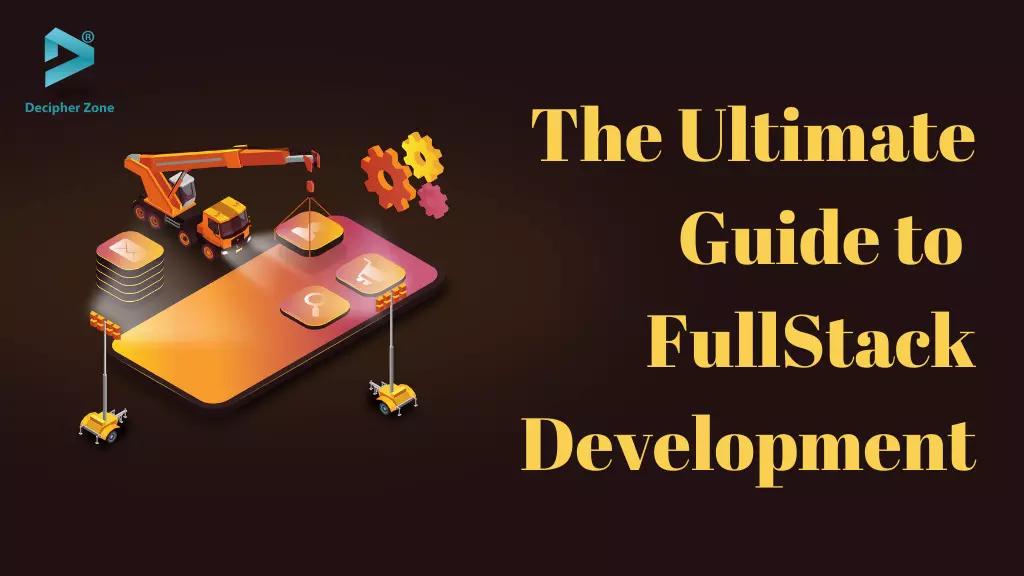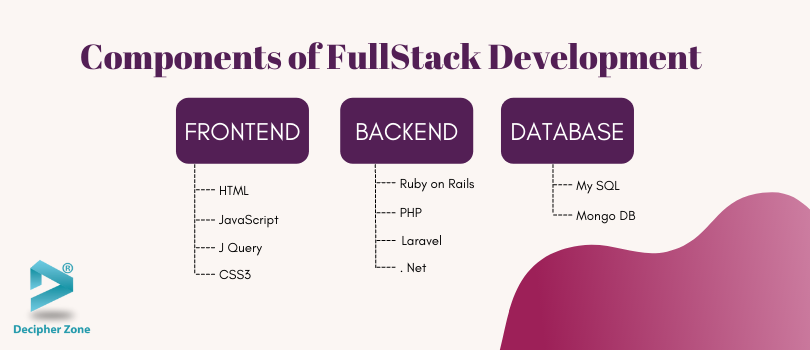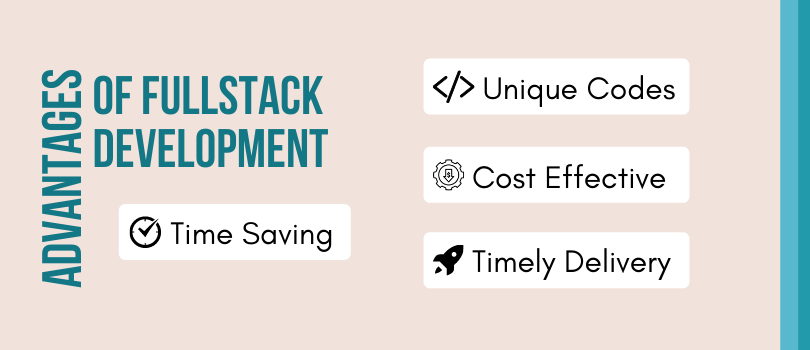Generally, when thinking of developing an app, the first thing we look for besides the plan is the technology and the frameworks, and according to that, we decide the development company and the development team to meet the requirements. Sometimes it even gets difficult to choose and find the right team for development because it requires different people, from different teams to build the entire app. For example, we need the Front end developer, the Back end developer, Database administrator, Quality assurance tester, and many more. What if all this work can be done by a single person or by a full stack development team? Well, you read it right there are individuals and app development companies who have expertise in doing so. In terms of the IT industry, they are called FullStack developers or FullStack development companies.
What is FullStack Development?
The demand for websites and applications has taken an immense rise in the last few years, and according to research conducted by Hackernoon, people and businesses prefer full-stack development companies to develop their projects as they find them convenient, time-saving, and cost-effective.
FullStack development refers to developers who work from start to end from designing to developing and lastly to deploying the website or application. It comprises everything that is required to build a website or an application. It is a one-stop solution for all the development needs and has been in demand ever since the term was introduced in the information technology industry.
Components of FullStack Development
Full-stack application development comprises two main things. The FrontEnd and the BackEnd development.
Front End Development
-
Also known as the client-side application, it includes the development of the graphical UI or the user interface through which the user can interact with that respective website. The languages used in Front end development are HTML, CSS, Javascript, JQuery, and many more.
Back End Development
-
It comprises the overall functionality of the app and the website including the server, database, API, and logic, also known as the server-side application. The most common languages used in backend development are PHP, Angular, Ruby on Rails, Node.js, .net, and many more.
Who is a FullStack Developer?
Full-stack developers are IT professionals who have expertise in developing both the frontend and backend parts of a website or a mobile application. According to a study by Stack Overflow in 2020, at least half of the developers consider themselves as full-stack developers, 55.2% specify themselves as back-end developers, and 37.1% determine themselves as front-end developers in full-stack development.
They are responsible for designing and developing the graphical part of the user interface along with the integration of the overall functionality of the application. Full-stack developers are the Jack of all trades in terms of development and are well versed in multiple technologies that are required for front-end and back-end development. Additionally, they also learned about the various libraries and tools that are used to develop an effective website/application.
The basic responsibilities of a full stack developer include:
-
Listing all the project requirements from clients
-
Analyzing the project requirements and producing solutions accordingly
-
Designing user interface
-
Creating API integrations, logics, and database
-
Testing for bugs in the codes and resolving them
-
Deploy them over the internet
Full Stack Development Technologies
In the information technology industry, frontend and backend are the two most important skills with increasing demand. Therefore companies are hiring professionals who are skilled in both the frontend and backend along with error handling to save time, manage things easily, and also reduce the cost of development for we are familiar with the proverb that ‘two is always better than one.’
The full-stack technologies are explained below for better understanding.
FrontEnd Technologies and Frameworks
The frontend technologies that a full-stack developer generally uses are:
- HTML - HTML short for HyperText Markup Language, is the basic language for someone from a development background. It is the foundation for any website which lets the developers design the structure and layout of a website.
- JavaScript - It aids in integrating the overall functionality of the website.
- CSS - CSS short for Cascading Style Sheets, helps in styling the content that is viewable to provide a certain feel and look on the website.
- Angular - It is an open-source framework written in TypeScript language. It offers the best development practices to solve challenges and the complicacies in development. Gmail, PayPal, Upwork are some of the popular web applications that use Angular.
- React - Also known as React.js, is also a popular open-source framework used in building components of the user interface. It also handles the view layer for applications and websites and helps in creating reusable components of the User Interface. One added benefit of this framework is that it can be used on both the client-side and server-side of the applications. Web applications like Netflix and Myntra are built using the React.js framework.
BackEnd Technologies and Frameworks
Backend technologies and frameworks complete the full-stack development and are used to build dynamic web apps. Here are a few examples of backend frameworks and technologies used in full-stack development:
- Node.Js - It is based on Javascript and is an open-source, cross-platform framework that helps the developers to create Web servers and networking tools to run the various core functionalities of the web or mobile applications. The main advantage of this framework is that it provides scalability and speed.
- PHP - It is super fast and flexible. PHP is a language used for the development of dynamic websites and web applications to cater to all the client requirements. It is considered an essential skill one should possess to become a full-stack developer. Web applications like Tumblr and Wikipedia are built on this programming language.
- Ruby on Rails - Another popular MVC (model–view–controller) framework used to develop dynamic top-notch web and mobile applications. From providing HTML templates to providing solid security it has covered everything required in the backend as well as frontend development. Popular web applications like Github and AirBnb are developed with this programming language.
Advantages of FullStack Development
Fullstack development itself is a one-stop solution for all your development needs. Hiring a Fullstack development team is most preferred nowadays. And talking about the benefits it provides, they are innumerable.
-
Versatile - Generally, frontend and backend development are skilled in the respective technologies, but the first and foremost benefit of choosing full-stack development is that the developers are well versed with both frontend and backend technologies and they can develop complex apps even from scratch with efficiency. The full-stack developer can carry out all the tasks of a backend developer and a frontend developer single-handedly.
-
Unique Codes - Gone are the days when in a team, the project lead has to coordinate with both the frontend and backend developers to combine them and make the application work. Now full-stack developers do it easily as they are skilled adequately to develop an application and write unique codes that work perfectly. This eliminates the need to combine and connect codes from two different ends of application development.
-
Cost Effective - Hiring a full-stack developer for the development of an application reduces the cost of development since the developer is already familiar with both the frontend and backend technologies. So, you do not need to invest double in developing an application.
-
Quick Fixes to Errors - Sometimes during the development of an application things do not function properly, maybe because of some error in the code. This can be resolved quickly as a full-stack developer is known for the placement of the codes and can identify the mistakes easily.
-
Easy Updates - Developing apps under full-stack technology helps a developer to make updates according to the client's requirements and release them easily. They are well versed with the codes and can optimize them when the app requires changes and where the code requires the additional feature to be visible on the web and mobile application as they are involved in both the frontend and backend part of the application.
Disadvantages of FullStack Development
The advantages of creating an application under full-stack development are appealing and allow one to decide instantly to develop apps under the same. But there are a few drawbacks that you should learn before deciding anything, after all this investment into your business also lets you shortlist the risks you might face. Although the drawbacks are the least here you should know them.
-
Overloading of Tasks - We are known that a full-stack development team is responsible for all the development stuff from start to finish. The entire development process depends on them which indirectly overloads them with too much work which may result in errors and then lead to extra time consumption and delay in delivery of the project.
Wrapping Up
A study by the United States Bureau of Labor Statistics states that there will be around 853,000 full stack developer jobs by 2024. The variety of technologies and frameworks that are used by developers and the property of the developers being versatile is an important reason why clients and development companies prefer hiring full-stack developers. In other words, full-stack development and developers are gaining immense popularity and have proved to be the right choice for app development by clients and companies.



